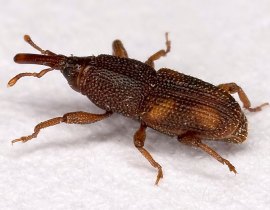Professional Pest Control & Wildlife Management
Rice Weevils
There is a Greater Rice Weevil Sitophilus zeamais and a Lesser Rice Weevil Sitophilus oryzae, the difference is one of size. The Lesser is 2.5mm and the Greater is 3mm, both can fly but require a warm day to take to the air.
Like other Weevils the Rice Weevil has a long snout with mouth parts at the end for feeding and boring into grains. Rice weevils are distiguishable from other weevils by the red/brown dots on the wing cases.
These are a serious pest to grain storage, rapid reproduction rates mean that in optimum conditions life cycles can be completed in four weeks, with the infestation explosion increasing numbers by twenty five times in a month!
-
Risks
Contamination of food stuffs and wastage of grains and stored products is the risk of having an infestation of Weevils. With such fast reproduction rates vast amounts of product is at risk of contamination and loss.
-
Treatment
The first step in dealing with an infestation of Weevils is to identify the source of the infestation which must be either destroyed or fumigated.
All surrounding areas need to be treated with a residual insecticide paying close attention to all cracks and crevices. When disturbed weevils become very active.
A ULV treatment can suppliment a residual spray treatment effectively, however good house keeping will be a crucial factor in eradicating Rice Weevils.
-
Life Cycle
Females bore holes into grains with their proboscis and may lay several eggs in each grain, only one will survive per grain (cannibalism). Once the eggs have been laid the female will plug the hole and move onto another grain eventually laying upto 400 eggs
Inside the grain the egg can hatch within a week and begin feeding on the endosperm of the grain, in good conditions the larvae stage will only be three weeks after which the larvae pupates inside the grain and will eventually emerge as an adult.
Related
- False Widow Spider Removal
- Cluster Fly help
- The trouble with fleas?
- Mole Catching in Suffolk
- Rats in the Garden
- Wasp Nest Control
- Rats in your chicken Coop
- Anaphylaxis
- Bee Swarms
- Becoming a Beekeeper
- Rare Breed Poultry
- Pest Control with Birds of Prey
- Un-marked vehicles available
- Rabbiting with Ferrets
- Myxomatosis
- Poll-Tex Mesh
- Honorary Member Russell Wallis
- Free Rabbit Control


